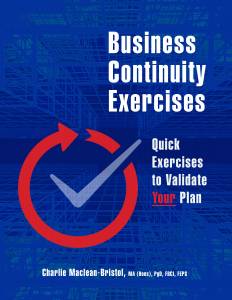A Checklist for the Loss of Employees
Charlie Maclean-Bristol, FBCI, FEPS, discusses the NHS COVID-19 tracking app, getting “pinged” and the consequences of self-isolation on businesses.
I’ve been seeking inspiration for this week’s bulletin, and it came to me about 20 minutes ago while listening to the news this morning. The news piece in question discussed how many UK businesses were struggling due to the loss of employees, who have been told to self-isolate because they were “pinged” by the NHS COVID-19 tracking app.
So far, during this pandemic, the main issue for most organisations has been the closure of whole sectors and having a reduced amount of customers to serve. As restrictions are eased and infection rates soar, the lack of employees is becoming a more significant issue for some organisations. It’s hitting the industries that cannot work from home and essential workers who have managed to keep their production going throughout the pandemic. I was revising our BIA templates yesterday and looking through the section on the minimum numbers you can operate with and how those numbers grow until you return to full competency. This element of the BIA should be used now.
Listening to the radio was also reminiscent of the pandemic planning I had conducted in the past. The main issue is, how will we operate with a loss of 10% – 25% of employees? Many companies are even planning for as high as 50% of their staff isolating for two weeks.
Here are some thoughts on how you can plan to deal with the loss of employees. As we are in the business continuity profession, we should already be implementing these practices now rather than later.
Loss Of Staff Checklist And How To Deal With A Loss Of Employees
-
- Think about how you’re going to deal with the loss of staff. Carry out some modelling for 10%, 25% and even 50% of staff being unavailable to come into work. Create a plan based on scenarios for how you will deal with the different numbers of staff. Remember, when 10% of people are off, it is more likely to be concentrated in one area, line or department rather than randomly across the whole organisation.
- Do not forget that self-isolating might not be a one-off.
- Create scenario plans for working with reduced staff and how you will deal with this operationally. You could:
-
-
- Shut down your operation for a few days. A friend of mine who runs a restaurant has just taken this approach.
- Concentrate production on a smaller number of items, perhaps the most profitable.
- Reduce the number of different options offered of the same item.
- Extend the lead time for products or the services you deliver.
- Simplify your products or services.
- Temporarily close some products or services.
- Bring forward a maintenance shutdown.
-
4.Think about the chain of self-isolation. Can another person who worked the same shift as someone who has to self-isolate also get “pinged?” Is it likely that they were in close proximity to each other for more than 15 minutes?
5. Think about what you can do to reduce groups of staff coming in contact with each other and remember the risks associated with canteens, break rooms, bathrooms and shared transportation. You could run more shifts or have smaller working groups to avoid everyone starting at the same time.
6. The end of the school term may help the situation.
7. You may want to know how many staff members use the NHS COVID-19 tracking app. Consider your attitude towards the app. Will you be encouraging your staff to download it or remain neutral? If you are tacitly or openly disapproving, you must think through the ramifications, possible risks and exposures associated with this. Communication with your staff for clarity should be strongly considered.
8. Follow government guidance closely. Is there the possibility for staff to take regular lateral flow tests to avoid isolating at home?
9. Review the practicality of using temporary staff to cover any gaps. Consider how long it takes to train someone. By the time they are ready to work, other workers will have finished their ten days in isolation. There is also the possibility of cross-skilling other employees within the organisation to take on key production or service delivery roles. Is it worth training or taking on additional staff now in anticipation of having an issue?
10. Review your supply chain and outsource activities. What is essential and what does your company need to do in order to ensure that they continue to deliver as they have promised? Keep in mind that there is already a lack of HGV drivers in the UK without COVID.
11. If you are thinking of hiring additional employees, consider the following:
-
- Temporary or agency employees
- Use contractors or outsource responsibilities
- Ex-employees
- Those on maternity/paternity leave
- Those on career breaks
- Apprentices or university students.
My take on this situation is that this will worsen before it gets better, either by the pandemic peaking or the government making changes to the rules. Like all good business continuity practitioners, you should be thinking about this now, rather than trying to solve these issues on the day of the incident.
This article was originally published by BC Training Ltd.
Charlie Maclean-Bristol is the author of the new book, Business Continuity Exercises: Quick Exercises to Validate Your Plan
 “Charlie drives home the importance of continuing to identify lessons from real-life incidents and crises, but more importantly how to learn the lessons and bring them into our plans. Running an exercise, no matter how simple, is always an opportunity to learn.” – Deborah Higgins, Head of Cabinet Office, Emergency Planning College, United Kingdom
“Charlie drives home the importance of continuing to identify lessons from real-life incidents and crises, but more importantly how to learn the lessons and bring them into our plans. Running an exercise, no matter how simple, is always an opportunity to learn.” – Deborah Higgins, Head of Cabinet Office, Emergency Planning College, United Kingdom
Click here for your FREE business continuity exercises!

